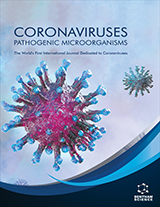
Abstract
Health professionals have been confronted with a series of challenges because of the ongoing pandemic of coronavirus disease 2019 (COVID-19). To save the greatest number of lives possible, it is essential to make a prompt diagnosis and admission to the hospital, as well as to stratify risks, make efficient use of intensive care services, choose appropriate treatments, monitor patients, and ensure a prompt discharge. Laboratory markers, also known as biomarkers, can provide additional information that is objective and has the potential to significantly influence various aspects of patient care. Clinical assessment is necessary, but laboratory markers can provide this information. The COVID-19 virus is not an infection that causes the respiratory system; rather, it is a multisystem disease that is caused by a diffuse system-wide process that involves a complex interplay of the immune, nervous, and endocrine systems in inflammatory and coagulative cascades. A wide variety of potential biomarkers have been uncovered because of a better understanding of the virus's effects on the body and how the body responds to them. Here, the pathophysiology and current data are examined in relation to various kinds of biomarkers, such as immunological and inflammation biomarkers, coagulation and hematological biomarkers, as well as cardiac, biochemical, and other biomarkers. This review provides a comprehensive analysis of the research on the association between biomarkers and clinical characteristics, viral load, treatment efficacy, and how this knowledge might most usefully contribute to patient care.
Keywords: COVID-19, biomarkes, virous infection, D-dimer, sickness, endocrine system.
[http://dx.doi.org/10.1016/S0140-6736(20)30183-5] [PMID: 31986264]
[http://dx.doi.org/10.1007/s15010-020-01401-y] [PMID: 32072569]
[http://dx.doi.org/10.18632/aging.103052] [PMID: 32268300]
[http://dx.doi.org/10.1016/j.lfs.2020.117788] [PMID: 32475810]
[http://dx.doi.org/10.1378/chest.126.4.1087] [PMID: 15486368]
[http://dx.doi.org/10.1186/s40560-020-00466-z] [PMID: 32665858]
[http://dx.doi.org/10.1080/17474086.2020.1831383] [PMID: 32997543]
[http://dx.doi.org/10.1016/j.hrtlng.2020.08.024] [PMID: 33041057]
[http://dx.doi.org/10.3390/v13030419]
[http://dx.doi.org/10.1515/cclm-2020-0573]
[http://dx.doi.org/10.1515/cclm-2020-0188]
[http://dx.doi.org/10.1016/j.jacc.2015.11.061] [PMID: 26916489]
[http://dx.doi.org/10.1148/radiol.2020203557] [PMID: 33320063]
[PMID: 31164237]
[http://dx.doi.org/10.1097/MD.0000000000010192] [PMID: 29561440]
[http://dx.doi.org/10.1016/S2352-3026(20)30151-4] [PMID: 32470428]
[http://dx.doi.org/10.1016/j.jcv.2020.104362] [PMID: 32305883]
[http://dx.doi.org/10.1016/S2352-3026(20)30145-9] [PMID: 32407672]
[http://dx.doi.org/10.1002/jmv.25819] [PMID: 32242950]
[http://dx.doi.org/10.3109/00313029109060809] [PMID: 1720888]
[PMID: 1558000]
[http://dx.doi.org/10.1007/s00011-018-1188-x] [PMID: 30288556]
[http://dx.doi.org/10.1016/j.cca.2020.06.013] [PMID: 32511972]
[http://dx.doi.org/10.3389/fimmu.2018.00754] [PMID: 29706967]
[http://dx.doi.org/10.1016/j.medmal.2020.03.007] [PMID: 32243911]
[http://dx.doi.org/10.1515/cclm-2018-0312]
[http://dx.doi.org/10.1038/sj.ijo.0801291] [PMID: 10997622]
[http://dx.doi.org/10.1016/j.cmi.2018.05.011] [PMID: 29870855]
[PMID: 10984072]
[http://dx.doi.org/10.1016/j.cmi.2014.12.026] [PMID: 25726038]
[http://dx.doi.org/10.1016/j.ijantimicag.2020.106051] [PMID: 32534186]
[http://dx.doi.org/10.1001/jamacardio.2020.1096]
[http://dx.doi.org/10.1016/j.chest.2019.06.040] [PMID: 31381883]
[http://dx.doi.org/10.1056/NEJM199610313351802] [PMID: 8857017]
[http://dx.doi.org/10.1016/j.jacc.2020.06.068] [PMID: 32652195]
[http://dx.doi.org/10.1016/j.jinf.2020.06.053] [PMID: 32592705]
[http://dx.doi.org/10.14814/phy2.14876] [PMID: 34042296]
[http://dx.doi.org/10.1002/jcla.23618] [PMID: 33078400]
[http://dx.doi.org/10.1098/rsob.200160] [PMID: 32961074]
[http://dx.doi.org/10.1007/s00281-017-0629-x] [PMID: 28466096]
[http://dx.doi.org/10.1136/annrheumdis-2020-218323] [PMID: 32978237]
[http://dx.doi.org/10.1016/S0140-6736(20)30628-0] [PMID: 32192578]
[http://dx.doi.org/10.1093/nsr/nwaa037] [PMID: 34676126]
[http://dx.doi.org/10.1016/j.cyto.2014.05.024] [PMID: 24986424]
[http://dx.doi.org/10.7150/ijms.53564] [PMID: 33628091]
[http://dx.doi.org/10.1146/annurev.immunol.021908.132612] [PMID: 19302047]
[http://dx.doi.org/10.1128/JVI.79.12.7819-7826.2005] [PMID: 15919935]
[http://dx.doi.org/10.1182/blood-2010-07-273417] [PMID: 21304099]
[http://dx.doi.org/10.3389/fimmu.2013.00391] [PMID: 24312098]
[http://dx.doi.org/10.1016/j.kint.2020.03.005] [PMID: 32247631]
[http://dx.doi.org/10.23876/j.krcp.20.177] [PMID: 34162049]
[http://dx.doi.org/10.1093/qjmed/hcv020] [PMID: 25636343]
[http://dx.doi.org/10.7326/0003-4819-130-6-199903160-00002] [PMID: 10075613]
[http://dx.doi.org/10.14740/jocmr4227] [PMID: 32655735]
[http://dx.doi.org/10.1016/j.virusres.2020.198089] [PMID: 32629085]
[http://dx.doi.org/10.1038/s41392-020-0148-4] [PMID: 32296069]
[http://dx.doi.org/10.1186/s12979-016-0079-7] [PMID: 27547234]
[http://dx.doi.org/10.1086/381535] [PMID: 14767818]
[http://dx.doi.org/10.3201/eid2608.201160] [PMID: 32384045]
[http://dx.doi.org/10.1016/j.ijid.2020.04.086] [PMID: 32376308]
[http://dx.doi.org/10.3389/fimmu.2020.00827] [PMID: 32425950]
[http://dx.doi.org/10.1590/S1679-45082015RB3438] [PMID: 26466066]
[http://dx.doi.org/10.1371/journal.ppat.1002098] [PMID: 21814510]
[http://dx.doi.org/10.1038/s41577-020-0331-4] [PMID: 32376901]
[http://dx.doi.org/10.1158/0008-5472.CAN-05-3842] [PMID: 16618742]
[http://dx.doi.org/10.1086/428855] [PMID: 15776367]
[http://dx.doi.org/10.1016/j.cytogfr.2008.01.001] [PMID: 18321765]
[http://dx.doi.org/10.1182/blood-2004-10-4166] [PMID: 15860669]
[http://dx.doi.org/10.1111/j.1365-2249.2004.02415.x] [PMID: 15030519]
[http://dx.doi.org/10.1172/JCI9232] [PMID: 10749577]
[http://dx.doi.org/10.1002/eji.1830260207] [PMID: 8617297]
[http://dx.doi.org/10.3389/fimmu.2020.01441] [PMID: 32612615]
[http://dx.doi.org/10.1111/all.14465] [PMID: 32562554]
[http://dx.doi.org/10.3390/v13091675] [PMID: 34578258]
[http://dx.doi.org/10.1055/s-0040-1713435] [PMID: 32557449]
[http://dx.doi.org/10.1182/blood.2020006520] [PMID: 32492712]
[http://dx.doi.org/10.1002/ajh.25824] [PMID: 32279346]
[PMID: 26716028]
[http://dx.doi.org/10.1111/jth.14848] [PMID: 32302435]
[http://dx.doi.org/10.1182/asheducation-2009.1.240] [PMID: 20008204]
[http://dx.doi.org/10.1111/jth.14768] [PMID: 32073213]
[http://dx.doi.org/10.1111/bjh.16655] [PMID: 32285448]
[http://dx.doi.org/10.1111/jth.14832] [PMID: 32278338]
[http://dx.doi.org/10.1054/blre.2001.0188] [PMID: 11914001]
[http://dx.doi.org/10.1016/S0092-8674(01)00477-9] [PMID: 11551503]
[PMID: 32523922]
 9
9 3
3




























